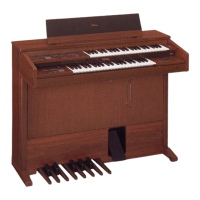Do you have a question about the Yamaha Electone F-400 and is the answer not in the manual?
Explains safety graphics on the enclosure and their meanings.
Basic precautions to follow when using any electrical or electronic product.
Precautions regarding power cords to prevent tripping or damage.
Prohibits using the product in wet or damp locations or near water.
Disconnecting power during extended periods of non-use or storms.
Preventing objects from falling or liquids from spilling into the enclosure.
Specifies conditions requiring professional servicing by qualified personnel.
Advises against servicing beyond user-maintenance instructions.
Warns about potential hearing loss from high volume levels.
Steps for plugging into an outlet and turning the F-400 on.
Setting the MASTER VOLUME to an appropriate level for the instrument.
Adjusting the overall sound level using the Expression pedal.
Details the 38 voice stops per keyboard and their footage settings.
Memorizing and recalling panel settings (voices, effects) using combination buttons.
Adding extra voices to the F-400 using special Custom Tone cards.
Step-by-step guide for inserting Custom Tone Cards into keyboard slots.
Using Combination controls to instantly change all panel settings.
Step-by-step process for memorizing panel settings to a combination button.
How to recall previously stored panel settings using combination buttons.
Function allowing continuous calling of stored registrations in order.
Turns on all voice stops simultaneously, except for specific custom tones.
Using a toe piston to activate the Tutti function with your foot.
Allows transposition of the instrument's pitch in semitone units.
Fine-tunes the instrument's pitch around the standard A3 frequency.
Terminals for controlling and transferring data with MIDI-compatible devices.
Details MIDI functions, what is transmitted, and what is recognized.
Lists MIDI Control Change messages and their corresponding values.
Details MIDI Program Change messages for different voices/combinations.
Lists common issues arising from unfamiliarity or external causes with solutions.
Addresses causes and solutions for crackling static-like noise.
Deals with interference from radio, TV, or other external sources.
Troubleshooting steps if no sound is heard through the speakers.
Addresses issues related to the sound output being too soft.
Explains why sound might differ from panel settings due to couplers.
Troubleshooting sound output issues when the Custom stop is turned on.
Lists all voice stops and custom stops for the Great keyboard.
Lists all voice stops and custom stops for the Swell keyboard.
Lists all voice stops and custom stops for the Pedal keyboard.
Lists all available coupler functions between keyboards.
Details combination memory locations and shift functions.
Lists all available input and output terminals on the instrument.
| Type | Electronic Organ |
|---|---|
| Keyboard | 49 keys (Upper), 49 keys (Lower), 13 keys (Pedal) |
| Voices | Flute, Strings, Brass |
| Effects | Vibrato, Sustain, Reverb |
| Amplifier | Built-in amplifier with speakers |
| Connectivity | Headphones |
| Power Supply | AC power |











